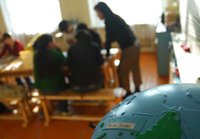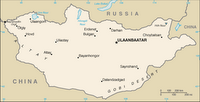By B. Bulgamaa
Wednesday - November 22, 2006All images copyright Luke Distelhorst
Following disputes concerning a previous director, students from Secondary School #116, the only school in Mongolia for visually impaired children, still suffer from a lack of resources, professionally trained teachers and help from the state authorities, according to ministerial officials. “Although the Mongolian state put more attention on disabled children’s education before 1990, it was lost from the state’s attention since that period,” B. Batbold, Chairman of Primary and Secondary Policy Coordination Department at the Ministry of Education, Culture and Science told MonInfo Wednesday.
“In the last two or three years the state only just started to pay a little attention to the education of disabled children,” he said.
Since 2004 the pupils of the visually impaired children’s school, Secondary School #116, the only one of its kind in Mongolia put demands to the Ministry of Education about improving the education environment and quality and the personal characters of the teachers and workers of the school were very bad, according to the students. Protests and a hunger strike eventually resulted in the changing of the school’s director, but even today the students frequently discuss the quality of their educational leaders.
“This year the Ministry just started to give us students’ books and until this year we couldn’t prepare for subjects because there was only one book for every other student and even the teacher had to take a book away from us to use,” students said Wednesday. Ts. Gelegzamts, director of the visually impaired children’s school who was hired two months ago after the student led protests said, “We should do a lot of things to improve the environment of study for pupils and must modernize under clear projects and plan for it.”
Of high concern to the students is having available exercise and physical education to maintain healthy bodies as some visually impaired students face risks and challenges in mobility. “The visually impaired children have a high risk to have a shortage of motion and physical education is just 90 minutes per week. We are thinking it is not enough for us because this subject is very important for us. Although our teacher is very good there is not enough equipment to improve motion in the sport hall,” children of the eight grade class told MonInfo Wednesday.
Disputes within the school between teachers and the children have only added to the difficulties of running the nation’s only school for the visually impaired.
“The very important subject, which teaches us about spatial orientation, has not been taught us yet,” said a senior class student. “We participated in just a two day training about how use the walking stick and that is all.” However, a school manager claimed that the students have all attended spatial management classes throughout their time at the school, a statement rejected by all the students in the 8th grade class.
The training manager of the school said, “Our teachers teach this subject to pupils and I attended this training. Maybe the children said untrue things to you.” Officials at the Ministry also stated that there is a lack of experts with training to teach the visually impaired students.
“These subjects are very important for the visually impaired children. It is true that there are not enough teachers at this school because Mongolia has not prepared this professional teacher since 1990 and teachers were prepared in Germany and Russia during the socialist system,” said Chairman Batbold.
Students also complained about music class, where the teacher was forced to bring in his personal instrument because of a lack of funding, and computer training which only lasts for 45 minutes a week and students must share the school’s only four computers.
Batbold said, “The hardest issue is preparing professional teachers in Mongolia. Another problem is the shortage of equipment and things of this school that could be supportted by the local companies and donor organizations’ assessment. For example we are talking about getting free internet service for this school from the Mobicom Corporation”.
“Pupils who graduated from this school last year were allowed to enter state universities without the requirement of passing entrance exams. This was an order from the ministry,” said Batbold. Students said that preceding last year there were no options for the visually impaired youth after finishing secondary school. “Before pupils couldn’t enter universities after they graduated this school and they were added as just one more domestic, unemployed visually impaired individual in Mongolia,” the children said.
UNICEF, Save the Children and World Vision organizations as well as the Ministry of Education had no official or unofficial numbers on the number of blind or visually impaired individuals in Mongolia, and commented that no studies have yet been done.
____________________________________
http://www.moninfo.org/content/view/379/18/lang,en/News and Information Association of Mongolia - www.moninfo.orgOnline daily news in English and Mongolian




 The extreme south is the Gobi, some regions of which receive no precipitation at all in most years. The name "Gobi" is a Mongol term for a desert, depression, salt marsh, or steppe, but which usually refers to a category of arid rangeland with insufficient vegetation to support marmots but with enough to support camels.
The extreme south is the Gobi, some regions of which receive no precipitation at all in most years. The name "Gobi" is a Mongol term for a desert, depression, salt marsh, or steppe, but which usually refers to a category of arid rangeland with insufficient vegetation to support marmots but with enough to support camels.